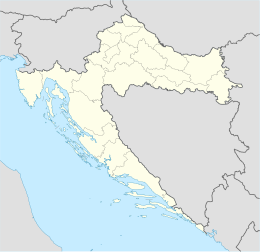Biševo

Biševo island seen from the airplane.
|
|
| Geography | |
|---|---|
| Location | Adriatic Sea |
| Coordinates | 42°58′N 16°0′E / 42.967°N 16.000°ECoordinates: 42°58′N 16°0′E / 42.967°N 16.000°E |
| Area | 5.8 km2 (2.2 sq mi) |
| Highest elevation | 239 m (784 ft) |
| Highest point | Straženica |
| Administration | |
|
Croatia
|
|
| County | Split-Dalmatia |
| Demographics | |
| Population | 15 (2011) |
Biševo (pronounced [bîʃɛv̞ɔ], Chakavian: Bisovo, Italian: Busi) is an island in the Adriatic Sea in Croatia. It is situated in the middle of the Dalmatian archipelago, five kilometers southwest of the Island of Vis. Its area is 5.8 km2 and it has a population of 15 (as of 2011). It is composed of limestone; the highest point is Straženica, 239 m high. In the center of the island there is a fertile field, the northern part of the island is covered with pine forests and the rest of the island is covered with maquis shrubland or bare rocks. The coastal sea belt is a rich fishing area. The main industries are viticulture and fishing.
A Benedictine monastery was founded on Biševo in 1050 by Ivan Grlić from Split, but it was deserted two centuries later because of the danger of pirates. The church of Saint Sylvester is preserved near the ruins of the monastery.
On the steep shores there are many caves, the most famous being Blue Cave. It has been accessible since 1884, and the approach to the cave is only possible by boat. It is 18 meters long, 6 meters deep, and 6 meters high. The entrance to the cave is only 1.5 meters high and 2.5 meters wide. Between 10 am and 1 pm sunbeams that penetrate through the submarine opening in Blue Cave are reflected from the white bottom floor, coloring the cave blue and objects in the water silver.
...
Wikipedia

